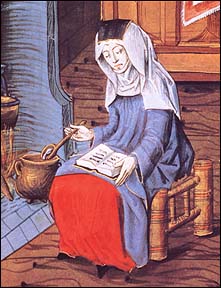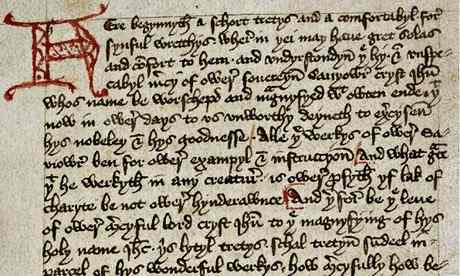Sometimes when the said creature was at sermons where Germans and other men preached, teaching the laws of God, sudden sorrow and heaviness filling her heart caused her to complain with mournful expression at their lack of understanding, desiring to be refreshed with some crumb of spiritual understanding of her most trusted and most entirely beloved sovereign, Christ Jesus, whose melodious voice, sweetest of all savours, softly sounding in her soul, said, ‘I shall preach to you and teach you myself, for your will and your desire are acceptable to me.’
Then her soul was so delectably fed with the sweet converse of our Lord, and so  fulfilled with his love, that like a drunk she turned herself first on one side and then on the other, with great weeping and sobbing, powerless to keep herself steady because of the unquenchable fire of love which burned very strongly in her soul. Then many people were amazed at her, asking her what was wrong with her; to which she, like a creature all wounded with love, and in whom reason had failed, cried with a loud voice: ‘The Passion of Christ slays me.’
fulfilled with his love, that like a drunk she turned herself first on one side and then on the other, with great weeping and sobbing, powerless to keep herself steady because of the unquenchable fire of love which burned very strongly in her soul. Then many people were amazed at her, asking her what was wrong with her; to which she, like a creature all wounded with love, and in whom reason had failed, cried with a loud voice: ‘The Passion of Christ slays me.’
The good women, feeling sorry for her sorrows and astonished at her weeping and crying, loved her much the more as a result. And therefore they, wanting to cheer her up after her spiriitual labour, through sings and tokens – for she did not understand their language – prayed her, and in a way compelled her, to come home with them, not wanting her to leave them.
Then our Lord sent her grace to have great love and great favour from many persons in Rome, both religious men and others. Some religious came to such of her countrymen as loved her and said, ‘This woman has sown much good seed in Rome since she came here; that is to say, shown a good example to the people, through which they love God more than they did before.’
One time this creature was in a church at Rome where the body of St. Jerome lies buried, which was miraculously translated from Bethlehem to that place and is now held in great reverence there, beside the place where St. Laurence lies buried. To this creature’s inward sight St. Jerome appeared and said to her soul, ‘Blessed are you, daughter, in the weeping that you weep for people’s sins, for many shall be saved hereby. And daughter, don’t be at all afraid, for it is a singular and a special gift that God has given you – a well of tears which man shall never take from you.’
With such manner of conversing he highly comforted her spirits. And he also gave great praise and thanks to God for the grace that he wrought in her soul, for unless she had had such spiritual comfortings it would have been impossible for her to have borne the shames and wonderings which she suffered patiently and meekly for the grace that God showed in her. (The Book of Margery Kempe, pages 135,136)
My friends, after taking several weeks off from looking at the lives of Medieval Christian women mystics, we now return to the 14th century. There are some very special women who lived during this century, Julian of Norwich, Bridget of Sweden (see post Sept. 12, 2016), Catherine of Siena, Dorothea of Montau, and Margery Kempe. Of these women, the most controversial is no doubt Margery Kempe. Her story is very intriguing, but she is worth studying because she was the very first English woman to write an autobiography. Her book gives us a good picture of Medieval life.
After reading the lengthy quote above, I’m sure many questions came into your mind. I don’t usually quote at such great length, but this time I want you to judge for yourselves.
Margery Kempe (1373 to 1440) lived in the prosperous medieval port of King’s Lynn in Norfolk. She married John Kempe and had fourteen children. Later in life she and her husband agreed to live separately. This was often done during the Middle Ages. The Church taught that celibacy was holier than marital relations. After the “purpose” for marital relations was fulfilled – having children – couples often moved apart. Some joined religious communities and spent the rest of their lives in serving Christ by working among the poor.
Being a married woman, Margery could not become a nun. So she chose to go on pilgrimages. Her longest pilgrimage was a journey to Jerusalem via Rome. In the quote from her book above, we see that some people seemed to have been blessed by her stay among them.
Margery began to have visions. She believed that Jesus spoke to her directly. Often in her visions she was an eyewitness to the events in the Gospels. Because she saw the damnation of souls she would weep as she had the visions. This weeping would be extreme and many times she would interrupt the sermons of the priests as they preached. Naturally she drew a lot of attention to herself. Some said she was a saint; others said she was putting on an act; still others said she had a demon.
When her husband became old and infirm, Margery returned home to care for him. On her way back to England she was arrested and examined as a heretic. At her examination however she revealed her thoroughly orthodox faith and she was able to continue on her way home.
At home one of Margery’s sons listened to her pleading and turned from his sinful ways to Christ. He married a good woman and they gave much comfort to Margery as she aged. Eventually both Margery’s husband and son died.
Margery traveled again and finally as an old women (she says 60) she returned home to Lynn to stay. She was met with mixed feelings. Some praised her piety; some censured her. Margery decided to write her autobiography, becoming the first English woman to do so. Below is a picture of a page of the only copy of her book in existence now put online by the British Library.

Because she could not read or write, Margery found a confessor to write her book. She wrote 89 chapters with the help of one scribe. Some time later with a new confessor she added 10 chapters.
So, what are we to make of Margery Kempe? She was a very intriguing woman. When she faced an examination by the Archbishop of York, Margery was secure enough in her own faith to reply boldly to the archbishop when questioned. The archbishop said very roughly to her, “Why do you weep so, woman?” She answered, “Sir, you shall wish some day that you had wept as sorely as I.” (p. 163) She was basically telling him that he needed to repent of his sins. The archbishop then examined her as to the Articles of Faith and she passed with flying colors. He did not know what else to do with her but let her go.
But what about the other extra-biblical things? What about her talking with dead saints or even talking with Jesus or Mary? What are we to make of her hysterics and her loud weeping? Were these real or a product of her imagination?
Margery saw her tears as prayers. She was weeping for sinners. She was weeping because of the suffering that Christ underwent for her sake and for all sinners. She wept because so many did not repent.
In the end, I believe that I will get to meet this extraordinary woman in Heaven. I have questions about some of her visions, but her sincerity is not in doubt. We must remember what the times were like. Mysticism was popular. She may seem strange to us today but she did not seem so to the many whose lives she touched.

